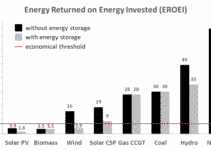New nuclear fission technology is being developed but over 50 nuclear reactors involves over $200 billion of development. China is developing over $100 billion of new nuclear fission power. China can afford to complete two CFR600 sodium fast gen IV reactors and a molten salt nuclear program. China also completed a commercial high temperature pebble bed reactor. The combined new fission reactor projects are over $10 billion worth of effort. They are turning on commercial reactors with the new technology.
Over 70% of the U.S. electricity grid is more than 25 years old.
Over 90% of the US nuclear reactors are over 30 years old.
There are still 92 nuclear reactors in the USA.
VOGTLE-4 is under construction and could start this year.
VOGTLE-3 started earlier in 2023.
Watts-Bar-2 started in 2016
Comanche peak-2 started in 1993.
A couple of reactors started in 1990.
1970-1989 was the main construction.
There have been many shutdowns of reactors that could have continued operating.
China has started operation of one CFR600. It is a sodium pooled generation IV fast neutron reactor. The project is known as Xiapu fast reactor pilot project. Construction of the reactor started in late 2017. These reactors are expected to be connected to the grid in 2023 and 2025. The reactor will have an output of 1500 MWth thermal power and 600 MW electric power. The fuel will be supplied by TVEL, subsidiary of Rosatom, according to the agreement signed in 2019. The CFR-600 is part of the Chinese plan to reach a closed nuclear fuel cycle. Fast neutron reactors are considered the main technology in the future for nuclear power in China.
UPDATE : China has plans to make hundreds of fast neutron reactors for power and to close the nuclear fuel cycle. Closing the fuel cycles means some reactors wastefully use fuel but the fast neutron reactors can use the even numbe uranium (238) and make energy from it.
China plans for the TMSR-SF to be an energy solution for the northwest half of the country, with lower population density and little water. The application of water-free cooling in arid regions is envisaged from about 2025.
China has a mostly new energy grid, South Korea’s grid is newer as well.
Molten Salt Reactors
Molten salt nuclear reactors are coming but it is new projects and multi-billion development and demo project. Older nuclear technology with proven designs are still the main ones being built and used for projects that were funded and started 5-10 years ago. The proven pressure water designs will continue to get built for at least two to three more decades.
There are startups working on molten salt nuclear technology. Those companies areFlibe Energy, ThorCon, Moltex, Seaborg Technologies, Terrestrial Energy and Transatomic Power.
China plans for the TMSR-SF to be an energy solution for the northwest half of the country, with lower population density and little water. The application of water-free cooling in arid regions is envisaged from about 2025. The US Department of Energy is collaborating with the China Academy of Sciences on the programme, which had a start-up budget of $350 million. TMSR commercial deployment is anticipated in the 2030s.
China is planning a 373 MWt/168 MWe liquid-fuel MSR small modular reactor. It will have a supercritical CO2 cycle in a tertiary loop at 23 MPa using Brayton cycle, after a radioactive isolation secondary loop. Various applications as well as electricity generation are envisaged. It would be loaded with 15.7 tonnes of thorium and 2.1 tonnes of uranium (19.75% enriched), with one kilogram of uranium added daily, and have 330 GWd/t burn-up with 30% of energy from thorium. Online refueling would enable eight years of operation before shutdown, with the graphite moderator needing attention.
Normal pressure water nuclear reactors have about 40-60 Gigawatt days per ton of uranium. The China planned molten salt reactor would be five to seven times more efficient with the uranium fuel.
The TMSR Centre at Shanghai Institute of Nuclear Applied Physics (SINAP, under the China Academy of Sciences) at Jiading is responsible. SINAP has two streams of TMSR development – solid fuel (TRISO in pebbles or prisms/blocks) with once-through fuel cycle, and liquid fuel (dissolved in fluoride coolant) with reprocessing and recycle. A third stream of fast reactors to consume actinides from LWRs is planned. The aim is to develop both the thorium fuel cycle and non-electrical applications in a 20-30 year timeframe.
The TMSR-SF stream has only partial utilization of thorium, relying on some breeding as with U-238, and needing fissile uranium input as well. It is optimized for high-temperature based hybrid nuclear energy applications. SINAP aimed at a 2 MW pilot plant initially, though this has been superseded by a simulator (TMSR-SF0). A 100 MWt demonstration pebble bed plant (TMSR-SF2) with open fuel cycle is planned by about 2025. TRISO particles will be with both low-enriched uranium and thorium, separately.
The TMSR-LF stream claims full closed Th-U fuel cycle with breeding of U-233 and much better sustainability with thorium but greater technical difficulty. It is optimized for utilization of thorium with electrometallurgical pyroprocessing. SINAP aims for a 2 MWt pilot plant (TMSR-LF1) initially, then a 10 MWt experimental reactor (TMSR-LF2) by 2025, and a 100 MWt demonstration plant (TMSR-LF3) with full electrometallurgical reprocessing by about 2035, followed by One GW demonstration plant. The TMSR-LF timeline is about ten years behind the SF one.
A TMSFR-LF fast reactor optimized for burning minor actinides is to follow. This would be used to close the nuclear fission fuel cycle. All nuclear waste (aka unburned Uranium 238 fuel) would be used.

Brian Wang is a Futurist Thought Leader and a popular Science blogger with 1 million readers per month. His blog Nextbigfuture.com is ranked #1 Science News Blog. It covers many disruptive technology and trends including Space, Robotics, Artificial Intelligence, Medicine, Anti-aging Biotechnology, and Nanotechnology.
Known for identifying cutting edge technologies, he is currently a Co-Founder of a startup and fundraiser for high potential early-stage companies. He is the Head of Research for Allocations for deep technology investments and an Angel Investor at Space Angels.
A frequent speaker at corporations, he has been a TEDx speaker, a Singularity University speaker and guest at numerous interviews for radio and podcasts. He is open to public speaking and advising engagements.


